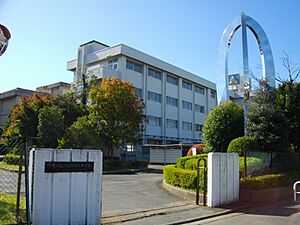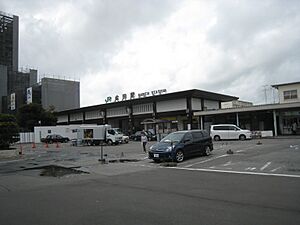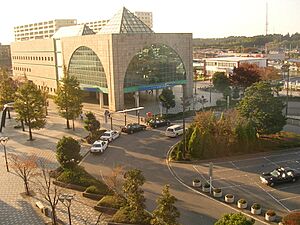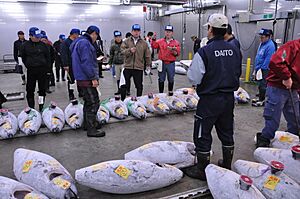Narita, Chiba facts for kids
Quick facts for kids
Narita
成田市
|
|||||||||||
|---|---|---|---|---|---|---|---|---|---|---|---|
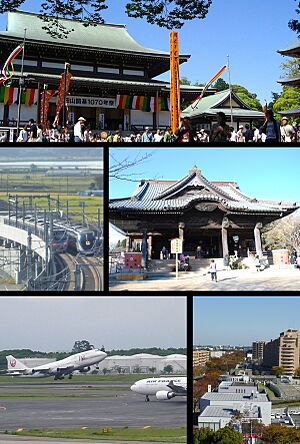
Top: Narita-san Shinshō-ji Temple, Middle left: Narita Sky Access Line, Middle right: Tōshō-ji Temple in Sōgo area, Bottom left: Narita International Airport, Bottom right: Narita Newtown in Karabe area
|
|||||||||||
|
|||||||||||
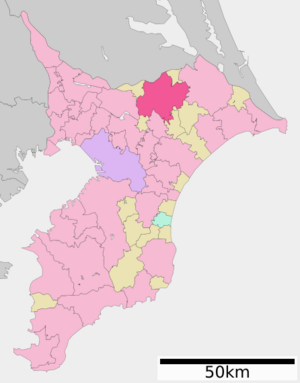 |
|||||||||||
| Country | Japan | ||||||||||
| Region | Kantō | ||||||||||
| Prefecture | Chiba | ||||||||||
| Area | |||||||||||
| • Total | 213.84 km2 (82.56 sq mi) | ||||||||||
| Population
(November 30, 2020)
|
|||||||||||
| • Total | 131,852 | ||||||||||
| • Density | 616.592/km2 (1,596.97/sq mi) | ||||||||||
| Time zone | UTC+09:00 (Japan Standard Time) | ||||||||||
| Phone number | 0476-22-1111 | ||||||||||
| Address | 760 Hanasaki-cho, Narita-shi, Chiba-ken 286-8585 | ||||||||||
| Climate | Cfa | ||||||||||
|
|||||||||||
Narita (成田市, Narita-shi) is a city located in Chiba Prefecture, Japan. As of November 30, 2020, about 131,852 people lived there in 63,098 homes. The city covers an area of about 213.84 square kilometers. Narita is famous for being home to Narita International Airport. This airport is one of the two main international airports that serve the Greater Tokyo Area.
Contents
Geography and Climate
Narita is in the northern part of Chiba prefecture. It's about 25 kilometers from Chiba city and 50 to 60 kilometers from central Tokyo. The city sits on the Shimosa Plateau. The older part of town and the newer areas are in the southwest. Narita International Airport is in the hills to the southeast.
Most of the city is between 10 and 40 meters above sea level. Farmland in the area gets water from the Tone River. This river runs along the border with Ibaraki prefecture to the north.
Neighboring Cities and Towns
Narita shares its borders with several other places:
- In Chiba Prefecture: Sakae, Inzai, Shisui, Tomisato, Shibayama, Tako, Katori, and Kōzaki.
- In Ibaraki Prefecture: Kawachi.
Narita's Climate
Narita has a humid subtropical climate. This means it has warm summers and cool winters. There is usually little to no snowfall. The average yearly temperature in Narita is 14.8°C. The city gets about 1498.4 mm of rain each year, with October being the wettest month. August is usually the warmest month, with temperatures around 26.0°C. January is the coldest, with temperatures around 3.9°C.
| Climate data for Narita (2003−2020 normals, extremes 2003−present) | |||||||||||||
|---|---|---|---|---|---|---|---|---|---|---|---|---|---|
| Month | Jan | Feb | Mar | Apr | May | Jun | Jul | Aug | Sep | Oct | Nov | Dec | Year |
| Record high °C (°F) | 19.4 (66.9) |
24.4 (75.9) |
24.9 (76.8) |
29.6 (85.3) |
31.3 (88.3) |
33.8 (92.8) |
38.4 (101.1) |
36.9 (98.4) |
35.5 (95.9) |
31.7 (89.1) |
25.3 (77.5) |
24.2 (75.6) |
38.4 (101.1) |
| Mean daily maximum °C (°F) | 9.4 (48.9) |
10.4 (50.7) |
13.7 (56.7) |
18.4 (65.1) |
22.7 (72.9) |
25.2 (77.4) |
28.9 (84.0) |
30.7 (87.3) |
27.1 (80.8) |
21.7 (71.1) |
16.9 (62.4) |
12.0 (53.6) |
19.8 (67.6) |
| Daily mean °C (°F) | 3.9 (39.0) |
5.0 (41.0) |
8.3 (46.9) |
13.0 (55.4) |
17.6 (63.7) |
20.9 (69.6) |
24.5 (76.1) |
26.0 (78.8) |
22.8 (73.0) |
17.4 (63.3) |
12.0 (53.6) |
6.5 (43.7) |
14.8 (58.7) |
| Mean daily minimum °C (°F) | −2.2 (28.0) |
−0.6 (30.9) |
2.5 (36.5) |
7.4 (45.3) |
12.7 (54.9) |
17.1 (62.8) |
21.1 (70.0) |
22.4 (72.3) |
19.3 (66.7) |
13.3 (55.9) |
6.7 (44.1) |
0.6 (33.1) |
10.0 (50.0) |
| Record low °C (°F) | −8.9 (16.0) |
−8.9 (16.0) |
−5.2 (22.6) |
−2.1 (28.2) |
0.8 (33.4) |
7.1 (44.8) |
15.0 (59.0) |
15.0 (59.0) |
8.4 (47.1) |
3.0 (37.4) |
−2.8 (27.0) |
−8.4 (16.9) |
−8.9 (16.0) |
| Average precipitation mm (inches) | 63.8 (2.51) |
69.7 (2.74) |
102.1 (4.02) |
125.1 (4.93) |
129.1 (5.08) |
144.1 (5.67) |
116.2 (4.57) |
121.8 (4.80) |
194.9 (7.67) |
257.6 (10.14) |
106.0 (4.17) |
68.1 (2.68) |
1,498.4 (58.99) |
| Average precipitation days (≥ 1.0 mm) | 5.1 | 6.8 | 9.9 | 10.3 | 10.1 | 10.8 | 9.3 | 7.6 | 10.8 | 11.6 | 8.8 | 6.1 | 107.2 |
| Source 1: Japan Meteorological Agency | |||||||||||||
| Source 2: Narita Aviation Weather Service Center | |||||||||||||
Population Trends
Narita's population has grown steadily over many decades. However, in recent years, the number of people living in the city has stayed about the same.
| Historical population | ||
|---|---|---|
| Year | Pop. | ±% |
| 1950 | 64,370 | — |
| 1960 | 61,869 | −3.9% |
| 1970 | 59,365 | −4.0% |
| 1980 | 85,897 | +44.7% |
| 1990 | 105,855 | +23.2% |
| 2000 | 116,898 | +10.4% |
| 2010 | 128,933 | +10.3% |
| 2020 | 132,906 | +3.1% |
History of Narita
People have lived in the Narita area since the Japanese Paleolithic period, which was about 30,000 years ago. Archaeologists have found ancient stone tools at the site of Narita Airport. Many shell middens (ancient garbage piles) from the Jōmon period and hundreds of burial mounds from the Kofun period have also been discovered.
The name "Narita" first appeared in written records in 1408. The city became an important center for trade and politics. It also grew as a pilgrimage spot after the famous Buddhist temple, Shinsho-ji, was built in 940 AD. During the Heian period, the area was involved in the revolt led by Taira Masakado. In the Edo period, Narita continued to thrive under the direct control of the Tokugawa shogunate.
Narita officially became a town on April 1, 1889. Parts of the town were damaged by air raids during World War II in 1945. On March 31, 1954, Narita became a city by joining with several nearby villages.
Growth really took off in 1966 when Prime Minister Eisaku Satō announced plans for Narita International Airport. Building the airport and new ways to get to Tokyo led to many new homes, shops, and factories in Narita. However, some people strongly disagreed with building the airport. This caused delays, and the airport didn't open until May 20, 1978.
On March 27, 2006, the towns of Shimofusa and Taiei joined with Narita.
Areas of Narita
Narita is made up of several interesting areas, each with its own unique feel.
Central Narita
Central Narita is the area around Narita Station, Keisei Narita Station, and the Narita-san Temple. The main street here is called Omotesandō (表参道). It has about 150 small shops and has been updated recently.
Narita New Town
Narita New Town is a planned neighborhood west of Narita Station. It has 16,000 homes and about 60,000 people living there. This area was designed in 1968, similar to new towns in the UK. Most of Narita's population lives here now. Many residents work at the airport or for airlines. There are also many government-supported housing projects in this area.
Kōzunomori Community
Kōzunomori is a suburban area south of Narita New Town. It's only about a 4-minute train ride from Keisei Narita Station. Around 12,000 people live here. Kōzunomori Station is next to a large department store called Your Elm.
Airport and Farm Areas
Narita International Airport is on the east side of Narita. This area, called Sanrizuka (三里塚), was historically used for farming. The building and expansion of the airport caused some disagreements among local farmers. Even though the airport changed farming in the area, the land around it is still home to many farmers.
Industrial Zones
Narita has two main industrial areas: Nogedaira (野毛平) and Toyosumi (豊住). These zones were created in the 1960s. They were designed to use Narita Airport for quick import and export of goods by air. A plant that repairs aircraft parts, called Japan Turbine Technologies, is located in the Taiei industrial estate.
Economy of Narita
In the past, Narita's economy was mainly based on farming. However, after Narita International Airport opened, the city's economy shifted. Now, it focuses more on transportation, logistics (moving goods), and tourism. Most of the airport is within Narita City. Many airport hotels and logistics centers are in nearby towns like Shibayama and Tomisato.
Large logistics companies like Prologis, FedEx Express, and Sagawa Express have big shipping centers in Narita. Several airlines also have their main offices here. For example, Nippon Cargo Airlines and Vanilla Air are headquartered at the airport. Spring Airlines Japan has its main office in the Kozunomori area.
Education in Narita
Narita has many schools for students of all ages.
Schools in Narita
Narita has 24 public elementary schools and one private elementary school. There is also one public school that combines elementary and junior high levels. For older students, there are nine public junior high schools and one private junior high school. The Narita City Board of Education manages the public schools.
The city also has four public high schools, which are run by the Chiba Prefectural Board of Education:
- Narita North High School
- Narita Seiryo High School
- Shimofusa High School
- Narita Kokusai High School
There is also a private school:
- Narita Private Junior and Senior High School
Public Libraries
The City of Narita operates the main Narita Public Library. In addition, each community center in the city has its own library branch.
Transportation in Narita
Narita is a major transportation hub, especially because of its international airport.
Airport Services
- Narita International Airport offers flights both within Japan and to other countries around the world.
Railway Connections
Trains are a popular way to travel to and from Narita. JR East's Narita Express and Keisei's Skyliner trains connect Narita Airport to central Tokyo.
![]() JR East – Narita Line
JR East – Narita Line
- Narita–Kuzumi–Namegawa
![]() JR East – Narita Line (Abiko branch line)
JR East – Narita Line (Abiko branch line)
- Narita–Shimōsa-Manzaki
![]() JR East – Narita Line (Airport branch line)
JR East – Narita Line (Airport branch line)
- Narita–Narita Airport Terminal 2·3–Narita Airport Terminal 1
![]() Keisei Electric Railway: Keisei Main Line
Keisei Electric Railway: Keisei Main Line
- Kōzunomori–Keisei Narita–Narita Airport Terminal 2·3–Narita Airport Terminal 1
![]() Keisei Electric Railway: Keisei Higashi-Narita Line
Keisei Electric Railway: Keisei Higashi-Narita Line
- Keisei Narita–Higashi-Narita
![]() Keisei Electric Railway: Keisei Narita Airport Line
Keisei Electric Railway: Keisei Narita Airport Line
- Narita Yukawa–Narita Airport Terminal 2·3–Narita Airport Terminal 1
Highway System
The Higashi-Kantō Expressway links Narita to Tokyo and Chiba City. Bus services, provided by Chiba Kotsu and Narita Kuko Kotsu, operate throughout the city. The Narita City Loop Bus runs on two circular routes, stopping at major shopping areas and hotels.
Major highways passing through Narita include:
 Ken-Ō Expressway
Ken-Ō Expressway Higashi-Kantō Expressway
Higashi-Kantō Expressway Shin-Kūkō Expressway
Shin-Kūkō Expressway National Route 51
National Route 51 National Route 295
National Route 295 National Route 296
National Route 296 National Route 356
National Route 356 National Route 408
National Route 408 National Route 409
National Route 409 National Route 464
National Route 464
International Connections
Narita has special relationships with cities around the world, called "sister cities" and "friendship cities."
Sister Cities
Narita is twinned with:
Friendship Cities
Narita also has friendship agreements with:
 Jeongeup, North Jeolla, South Korea (since 2002)
Jeongeup, North Jeolla, South Korea (since 2002) Jung District, Incheon, South Korea (since 1998)
Jung District, Incheon, South Korea (since 1998) Næstved, Denmark (since 2003)
Næstved, Denmark (since 2003) Xianyang, Shaanxi, China (since 1988)
Xianyang, Shaanxi, China (since 1988)
Fun Places to Visit
Narita has many interesting places to explore, from ancient temples to lively markets.
- Narita-san Shinsho-ji Temple: A very famous and historic Buddhist temple.
- Shiseki Park: A nice park to relax and enjoy nature.
- Chiba Prefectural Boso Fudoki-no-oka Museum: A museum where you can learn about the history and culture of the Boso region.
- Narita Wholesale Market: A bustling market where you can see fresh produce and seafood, including tuna auctions.
- Narita Peace Pagoda: A beautiful pagoda dedicated to world peace.
Famous People from Narita
Many talented individuals have come from Narita, including athletes, actors, and musicians.
- Yuji Funayama, professional footballer
- Yusuke Igawa, professional footballer
- Yoshio Inaba, actor
- Manabu Iwadate, professional baseball player
- Yuki Karakawa, professional baseball player
- Takeharu Kunimoto, musician
- Yōko Oginome, singer
- Sakura Sōgorō, a folk hero from the Edo period
See also
 In Spanish: Narita (Chiba) para niños
In Spanish: Narita (Chiba) para niños









